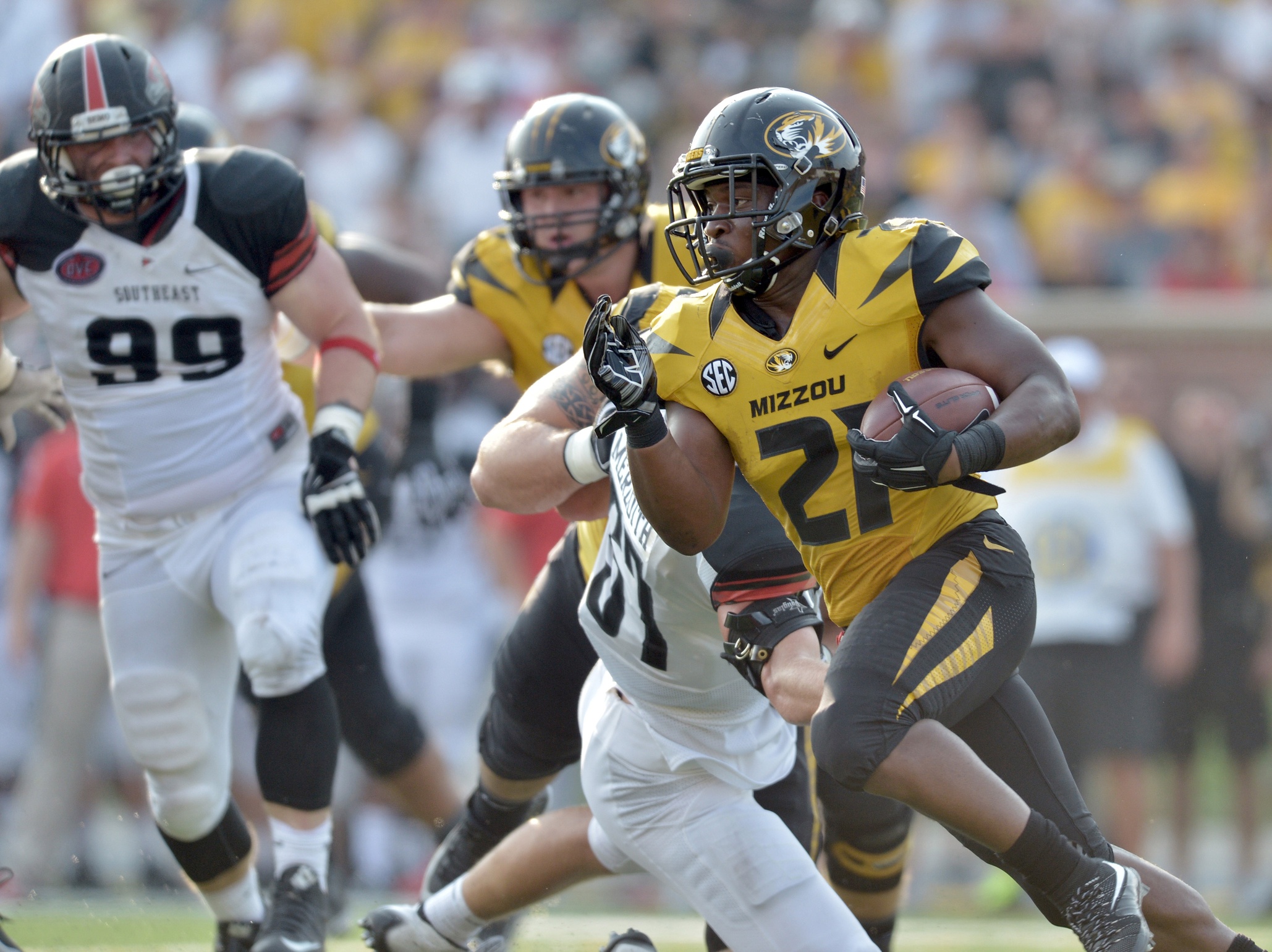Drew Lock and the Missouri Tigers can't be that bad again ... or can they?
Look at it this way, Missouri fans: It can’t get much worse.
In 2015, the Tigers were historically bad offensively, finishing 125th in the country in total yards and averaging an anemic 13.6 points per game.
As is usually the case, the quarterback position took a good portion of the blame. Maty Mauk and Drew Lock combined to complete only 49.9 percent of their passes and assembled a touchdown-to-interception ratio of just 10-to-12. Their aggregate passer efficiency rating of 97 — 112.2 for Mauk, 90.5 for Lock — would have finished outside the top 100 nationally among qualifiers.
Think of how ineffective Johnny McCrary was for Vanderbilt. Now realize he was more productive than Lock.
Mizzou finished 5-7 after a 4-1 start. In five of its seven losses, coach Gary Pinkel’s squad failed to crack double digits on the scoreboard. Even one of its Ws was a 9-6 taffy pull over Connecticut.
Both on the field and off, there wasn’t a college football program in 2015 that dealt with more drama than Missouri. Mauk was suspended multiple times, which led to Lock unexpectedly being thrown to the wolves as a true freshman. Pinkel abruptly retired — none of his players saw it coming — after disclosing that he is battling non-Hodgkins lymphoma. Racial strife led to some high-profile resignations on campus.
No team in the SEC more desperately needed to hit the reset button than the one in Columbia.
As the locker room turns the page to 2016, Barry Odom has replaced Pinkel. Mauk was dismissed and is hopefully getting his life in order. Lock is bruised but, with any luck, not permanently scarred.
Full of potential at 6-foot-4 and 205 pounds, Lock was originally a four-star recruit from Lee’s Summit (Mo.) High School. He chose to stay in the Show Me State despite some pretty impressive offers from the likes of Ohio State and Texas — fellow SEC members Kentucky, Ole Miss and Tennessee wanted him, too. His TD-to-INT ratio his last two years at the prep level was a terrific 63-to-12.
While Lock wasn’t supposed to lead the huddle right away, Mauk’s personal demons got the best of him.
“Lock had some nice moments in his debut season, but he looked like he wasn’t really ready for that role,” Nate Latsch told Saturday Down South. He covers Mizzou for Black and Gold Illustrated. “Most freshmen quarterbacks aren’t. But he didn’t get much help from his offensive line, running game or the Tigers’ young wide receivers, either. Lock wasn’t good, but the struggles offensively were across the board.”
As detailed above, the numbers highlight the fact that Missouri was dreadful in every capacity on offense.
The team’s top two tailbacks didn’t even combine for 1,000 rushing yards, as Ish Witter ran for 518 and Russell Hansbrough had 436. Witter’s longest run was only 27 yards, while Hansbrough’s best was just 26.
Hansbrough, a senior, dealt with some especially tough sledding due to a pesky ankle injury and poor play around him. As a junior the year before, he rushed 205 times for 1,084 yards, which was good enough to pop up on the radar of pro scouts. However, these days he’s generating zero buzz ahead of the NFL draft and likely won’t hear his name called in Chicago.
Few QBs, especially one as green as Lock, would have enjoyed any success with so little ground support.
“The Tigers ran for nearly 2,500 yards during the 2014 season and averaged 4.6 yards per carry,” said Latsch. “In 2015, with Mauk and Lock splitting time at quarterback, Mizzou ran for 1,385 yards and averaged 3.5 yards per carry.”
Don’t expect Witter to be the every-down back, as he’ll have plenty of competition during spring ball.
“Ish Witter was the leading rusher last season, but that isn’t saying much,” said Pete Scantlebury, who covers the Tigers for Power Mizzou. “He seems, at best, like a solid rotational guy, but not a starter. Other than him, Missouri has a lot of inexperience. Look for redshirt freshman Ryan Williams to get a long look. The staff has to hope that the focus is there for former JUCO transfer Chase Abbington this spring, too.”
a little help, please?
Aside from the ball carriers, the pass catchers didn’t pick up much of the slack, either.
J’Mon Moore led the club in both receptions and yardage, although his statistics are more in line with those of a third or fourth option in a respectable aerial attack. He totaled 29 catches for 350 yards.
Nate Brown’s stat line was similar to Moore’s, as he was credited with 27 grabs for 326 yards and also paced the Tigers in touchdowns through the air — he had 4 to Moore’s 3. Wesley Leftwich was the only other player on the roster to reel in more than 17 passes. Even Hansbrough, usually a tough matchup out of the backfield at 5-foot-9 and 195 pounds, averaged a lifeless 3.5 yards per catch.
Nevertheless, Lock’s erratic arm would have been a challenge for even the most competent receiving corps.
“I do have questions about Lock’s decision-making and where he chooses to go with the football,” Latsch said, “but I think he’ll be better off because of the experience he gained last fall and eventually become the quarterback he was expected to be.”
Having some more options would surely help Lock, who needs a primary target that commands the pigskin.
“Two other younger players to watch for are Johnathan Johnson and Justin Smith, who each redshirted in 2015,” Scantlebury said. “Johnson is a shorter slot receiver. Smith is a 6-foot-7 outside threat. Each showed flashes in preseason camp last year.”
The positives were few and far between, but Lock did put some SEC-worthy ability on display. In his first career start after Mauk’s initial suspension, he was 21-of-28 with 2 TDs and 0 INTs in a victory over South Carolina. Six weeks later, he threw for a career-high 244 yards in a win over BYU.
Mizzou may be in rebuilding mode on his side of the ball, but Lock is now unquestionably the starter under center. Witter is only a rising junior, although his upside might be somewhat limited. Both Moore and Brown are also rising juniors, while Alabama transfer Chris Black — he’s eligible to play immediately — was a big-time wideout recruit that never fit in with the Crimson Tide.
The cupboard isn’t bare at the skill positions. Protection up front, however, could be an issue.
“I have fewer questions about Lock than I do the offensive line,” Latsch said, “which wasn’t good last season and will lose two experienced guys in Connor McGovern and Evan Boehm, who will be playing in the NFL next season.”
new leadership = better production?
Odom was hired to help keep the program relatively stable post-Pinkel. It won’t be identical, though.
“As for talent around Lock, Missouri has to get its offensive line situation sorted out,” said Scantlebury. “That’s the most important part. The old staff did not do well with giving younger players time to prove themselves. The new staff under Barry Odom does not seem as beholden to seniority as Gary Pinkel was.”
McGovern and Boehm were better individually than the line as a whole, but replacements are still required.
“JUCO transfer Tyler Howell may not be starting at left tackle to begin spring practice,” Scantlebury said. “However, the hope is that he will take a hold of the job soon. Missouri has not had solid success with JUCO offensive linemen, but Howell may be one of the most developed they’ve signed.”
Now in charge of putting Missouri’s offense back together again is new offensive coordinator Josh Heupel.
A national championship-winning signal caller at Oklahoma and former draft pick of the Miami Dolphins, Heupel comes to the Tigers after a one-year stint as associate head coach, OC and QBs coach at Utah State.
The Aggies may not have been an offensive juggernaut last year — 93rd in total yards, 71st in rushing, 88th in passing — but they did average 29 points per game. Prior to taking the post in Logan, Heupel spent nine years on the staff of his alma mater. First as quarterbacks coach and then promoted to co-offensive coordinator, Heupel and the Sooners consistently fielded a high-powered bunch.
Still, he won’t have the kind of athletes in Columbia that he had at his disposal in Norman.
“We’ll know a lot more about what the Tigers offense will look like when they start spring practice this week, but Heupel has a tough job in turning around an offense that was one of the worst in the country last season,” Latsch said. “We know Mizzou wants to play more up tempo and run more plays, but can the Tigers’ young skill-position players and inexperienced offensive line make enough progress?”
Throwing a grenade on the previous playbook and starting over means Mizzou needs to get back to basics.
“Heupel brings experience and has a strong résumé,” Latsch said, “but he’ll probably have to do more teaching than he has in the past.”
who’s behind lock?
Not only does Heupel need to put everything he has into Lock, but the backup situation is also unsettled.
“The Tigers parted ways with Mauk this offseason after his off-the-field troubles, but they also lost reserve quarterbacks Corbin Berkstresser and Eddie Printz to graduation and transfer, respectively,” Latsch said. “Those were the three most experienced QBs on the roster in 2015.”
The contenders for the No. 2 job behind Lock are former three-star signees Marvin Zanders and Jack Lowary.

“Zanders is a dual-threat QB but has never thrown a pass in college,” Latsch said. “Lowary started one season at Mater Dei High School in California and then had a good JUCO season at Long Beach City College last fall, but Missouri was the only school to offer him a scholarship.”
Even outside of the game’s most important position, the entirety of the depth chart must be solidified.
“Missouri has to find solid backups,” Scantlebury said. “Looking at the roster, that’s a huge question mark.”
While he won’t be arriving until August, eventually Micah Wilson will be added to the mix at QB.
Another three-star prospect from Tulsa (Okla.) Lincoln Christian School, Missouri was the only Power 5 program to make Wilson an offer. The Tigers flipped him from Boise State late in the recruiting process.
Wilson’s numbers are nothing short of breath-taking, even if they need to be taken with a grain of salt — spread systems have made the passing game much more prolific in high school. After throwing for 30 TDs as a sophomore in 2013 and 34 more as a junior the following year, the 6-foot-4, 195 pounder went bananas this past fall as a senior. Not only did he throw for 56 scores, but he was only picked off twice.
The Tigers would prefer to give Wilson some time to watch and learn as a redshirt.
a big responsibility
Lock, however, had no such luxury. Yes, the line needs to protect better. Yes, the runners need to break more tackles. Yes, the receivers need to get open more consistently. Lock is the trigger man, though.
In all likelihood, Lock will make or break Mizzou’s season. If he turns into the kind of passer that caught the attention of Urban Meyer and Charlie Strong as a high schooler, then Odom has a chance to right the ship in Year 1. Making another pass at the SEC East appears to be a long shot, but the same was said in 2013 and 2014 — the Tigers surprisingly won the division both times.
Lock was overmatched taking over for Mauk last year. But if Lock can’t get it done now, it’ll be déjà vu.
“If Lock struggles again next season,” Latsch said, “the Tigers don’t have an experienced guy they can turn to.”
At least they had an experienced coach in Pinkel. That’s not the case anymore. Odom has his hands full.




